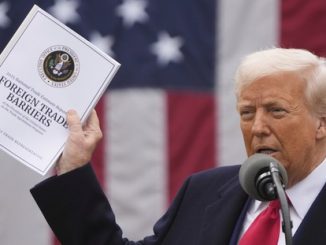
| Published April 8, 2025
President Donald Trump asserted that “virtually every country wants to negotiate” in response to the comprehensive reciprocal tariffs his administration announced on April 2, referred to by Trump as “Liberation Day.” These tariffs include a universal 10% levy on imports, with higher rates for specific nations, such as 34% on Chinese goods and 20% on European Union products.
Treasury Secretary Scott Bessent reported that nearly 70 countries have approached the U.S. to discuss these tariffs, highlighting Japan’s prompt engagement. Commerce Secretary Howard Lutnick noted that approximately 50 countries have contacted the U.S. regarding the tariffs, emphasizing the administration’s firm stance on proceeding with the measures.
These developments underscore the significant global impact of the U.S. tariff strategy, prompting widespread diplomatic outreach and signaling potential shifts in international trade relations.
🌍 Implications of Trump’s Global Tariff Push
President Trump’s declaration that “virtually every country wants to negotiate” following his April 2 “Liberation Day” tariff announcement has far-reaching geopolitical and economic consequences. Here’s a breakdown of the key implications:
🔹 1. Global Trade Realignment
-
Implication: Dozens of countries rushing to negotiate suggests that Trump’s tariffs are forcing nations to reassess trade deals.
-
Significance: This could lead to a wave of bilateral trade agreements favoring U.S. interests—reversing decades of multilateral globalization strategies.
🔹 2. Increased Costs for Consumers & Businesses
-
Implication: A universal 10% tariff (and higher for countries like China and the EU) raises import costs.
-
Significance: These costs are often passed down to U.S. consumers and manufacturers, possibly fueling inflation or supply chain reshuffling.
🔹 3. Diplomatic Pressure as a Tool
-
Implication: The fact that 50–70 countries reached out shows Trump’s use of economic pressure as diplomatic leverage is having an effect.
-
Significance: This may establish a negotiation-by-threat model, where access to the U.S. market is used to extract better trade terms.
🔹 4. Challenge to WTO & Global Trade Institutions
-
Implication: Unilateral tariffs bypass institutions like the World Trade Organization.
-
Significance: This weakens traditional global trade norms and could encourage other countries to act unilaterally, destabilizing the rules-based system.
🔹 5. Political Leverage for 2024 and Beyond
-
Implication: Trump’s aggressive tariff stance is rallying his base and could frame him as a strong negotiator ahead of the 2024 election (if still ongoing).
-
Significance: If successful, it may redefine economic nationalism as a winning political strategy for conservatives.
🧾 Overall Takeaway
Trump’s sweeping tariff strategy is a bold move that’s shaking up global trade dynamics. By imposing broad import taxes and signaling willingness to negotiate only on U.S. terms, he’s turning economic pressure into political leverage.
This approach is already prompting dozens of countries to the table—proving that Trump’s tough talk has real international ripple effects. But while it may secure stronger trade deals in the long run, it also risks higher costs for Americans, trade tensions with key allies, and potential backlash from global markets.
In short: Trump’s tariffs are forcing the world to listen—but at a cost.






Be the first to comment